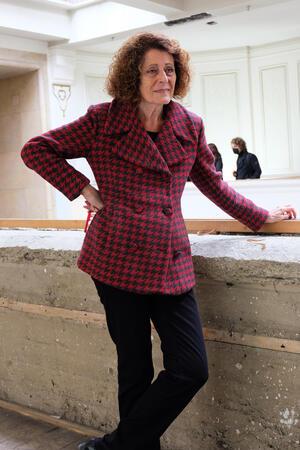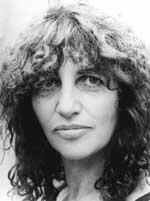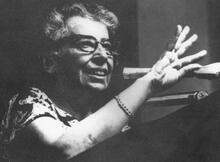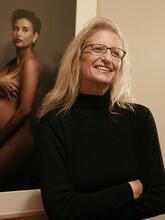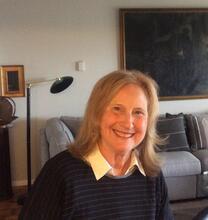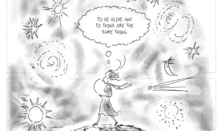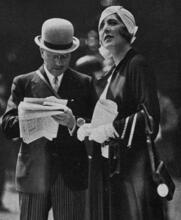Rachel Salamander
Rachel Salamander was born in 1949 in a DP camp in Germany. In 1982, she established the Literaturhandlung in Munich, a bookshop specializing in Jewish literature with one of the largest collections of books in Germany about Judaism. It is also a meeting point for readings, performances, and speeches. Salamander opened her second Literaturhandlung in Berlin in 1992 and her third in Fürth in 1999. Salamander is also an editor and publisher, publishing multiple works about German Jewry and DP camps after World War II. She served as editor of the weekly supplement Literarische Welt (Literary World) of the newspaper Die Welt, and in 2004, she helped organize Tarbut, the second Jewish cultural congress. Since 2015, she has served as the Deputy Chairwoman of the Supervisory Board of the German publishing house Suhrkamp Verlag.
Early Life and Family
“The persecution and annihilation of Jews belong to my life as far as my memories reach back. They are the facts of my existence, even though I was never subjected to them. Because of this topic I cannot choose a historical perspective.”
Rachel Salamander was born in 1949 in the DP camp Deggendorf/Niederbayern. Her parents, Samuel Salamander (b. Poland 1913, d. Germany 1996) and Rywa (née Blaitman, b. Poland 1918, d. Germany 1953) arrived in Germany in 1946 from Russia and lived there as “stateless” persons. Samuel was an ironworker. Rywa’s entire family had been killed by the Germans, except for one sister, Tola (b. Poland 1916, d. Germany 1951).
In 1970 Salamander completed her schooling in Munich and from 1970 until 1974 studied German and Romance literature and philosophy at the Ludwig Maximilian University in Munich. Her dissertation (1982) was on the theory of cognition in hermeneutics (Dilthey, Rickert, Kant and Hegel).
Bookstores and Publishing Career
Rachel Salamander is a well-known personality in Munich, where she established a prominent bookshop, the Literaturhandlung, in 1982. This bookshop specializes in Jewish literature and has one of the largest collections of books in Germany about Judaism. It is also a noted meeting point for wide-ranging activities, readings, and performances, and also an arena for speeches and discussions. In 1992 Salamander opened her second Literaturhandlung in Berlin and her third in Fürth (Bayern) in 1999. These bookshops indicate the success of her idea of connecting literature, reading, and meeting people who are knowledgeable about Jewish culture and religion. In 2000 Salamander was asked to succeed Julian Nida-Rümelin, who headed the cultural board of the city of Munich and had been appointed Minister of Public Works, but she refused because of her main occupation.
In 1986 Salamander received the Ernst Hoferrichter Prize, the Cultural Prize of Honor of the city of Munich. She married in 2000.
Rachel Salamander is not only the manager of the famous Literaturhandlungen but also a writer and publicist. Her past and her memories as a child growing up in a DP-camp in Bayern led Salamander to become a co-editor with Jacqueline Giere (Fritz Bauer Institute, Frankfurt) of the publication “Ein Leben aufs neu: das Robinson-Album; DP-Lager, Juden auf deutschem Boden 1945” (“A Life Anew: The Robinson Album; DP camps: Jews in German Territory 1945–1948,” 1995). In Salamander’s preface, she insisted that people should know about DP camps, maintaining that even today ignorance reigns, just as it did two years after the end of World War II. Salamander argues that this ignorance stems from the fact that the history of Jews in Germany immediately after World War II was not recognized by the public or by individuals, who thrust it aside. This “remnant of rescued people,” as they called themselves, survivors of the concentration camps or refugees from the Soviet Union and Poland, had appeared on the public stage again after the war. But nobody had expected so catastrophic and gigantic a stream of refugees, who rapidly became an enormous problem pressing on the conscience of many Germans. What was to be done with so many displaced persons, without a place to stay, without a home in the country of the perpetrators? In May 1953 the Süddeutsche Zeitung referred to the Föhrenwald DP camp as a “waiting room of unhappy people.” These refugees were stigmatized by the tattoos on their skin. Their location was extraterritorial. As a result, the DPs learned to govern themselves. They started to create an East European (Yiddish) Small-town Jewish community in Eastern Europe.shtetl in Germany. The rhythms of life were dictated by Jewish prescriptions, rules, and statutes. Yiddish was the language of the camps.
Born in the Deggendorf DP camp and growing up in another DP camp, Föhrenwald, near Munich, Salamander experienced the last breath of the special world that had once been Jewish life in Eastern Europe. People bore numbers on their arms and parents grew old very early, before their time. They appeared far away from life, untouchable, and with an uncanny knowledge. The Föhrenwald DP camp was closed in February 1957, having existed without any public recognition for twelve years after World War II. This is the resumé of Salamander’s growing up as a DP child, like thousands of children in the DP-camps in the American occupation zone of Germany.
Editing and Photography
In 1990, prior to her publications about DP camps, Rachel Salamander edited “Die jüdische Welt von Gestern, 1860–1938” (The Jewish world of yesterday, 1860–1938). It includes her translation into German of a Yiddish text by Moische Schulstein, “Ch’ob Gesejn A Barg/Ich Habe Einen Berg Gesehen” (I have seen a mountain). Among the prominent contributors to this volume were Schalom Ben-Chorin, who wrote about Jewish faith; Marcel Reich-Ranicki, who wrote about outcasts and provocateurs in literature, science, and the arts; the historian Julius Schoeps on the emancipation and national and political identities; and Joachim Riedl on the world of the shtetl and the birth of modernity—the Janus-face of assimilation, as Hannah Arendt called it.
To keep this lost Jewish world alive, Salamander uses photography, which appeared in the nineteenth century as a completely different medium, expanding the written word and documents. Through the eye of a camera the most intimate and obvious details of changing life become remarkable when presented in a picture. Minor matters attain the status of an immortal visual witness. Confronted with pictures of the Holocaust and the persecution of the Jews, rather than with words, people began to understand what had happened under Hitler’s dictatorship. They were forced to see what they had not wanted to see. As Hannah Arendt maintained in The Origins of Totalitarianism (1951) and her essay “The Aftermath of Nazi Rule: Report from Germany” in Commentary (1950), texts, written memories, and chronicles fill the virtual vacant places which pictures open up.
Notable Speeches and Publications
In a speech entitled “Hier sehen wir das fürchterlichste Verbrechen … Vom deutschen Widerstand und der Judenverfolgung” (Here we see the most fearful crime: On German resistance and persecution of Jews) in memory of the victims of the Weiße Rose (White Rose), held at the Ludwig Maximilian University in Munich in February 2000, Salamander connected past and present. She recalled that the end of her childhood as a DP child, living in an extraterritorial Jewish world as a Jewish minority within a German majority, was the time that prompted her interest in a resistance movement under Nazi rule. Therefore she learned about the White Rose resistance group under the leadership of Hans and Sophie Scholl and other students such as Alexander Schmorell. This was the most outstanding resistance movement other than the German Women of the Rosenstraße in Berlin, who rescued their Jewish husbands from annihilation. However, Salamander’s thinking about resistance and opposition against the Hitler regime led to disillusionment because the organized resistance ignored the annihilation of Jews. There was no connection established between the two. In her commemorative address, Salamander expressed her great disappointment at this fact.
“Hans Jonas: Erinnerungen” (Hans Jonas: Memories), based on dialogues between the philosopher Hans Jonas and Rachel Salamander, was published in 2003. Salamander’s preface of memories of her Jewish friend Hans Jonas begins with a quotation from Hannah Arendt: “Clearly, this is the book for which the good God had you in mind.” Salamander started her dialogue with Jonas by discussing her reading of one chapter of his The Principle of Responsibility, which Jonas wrote in German after a long period of writing in various foreign languages. Indeed, Salamander presents this charming philosopher as a global player who likes to cross the different border lines between the philosophy of classical antiquity, quoting from the original Greek and Latin in his book Gnosis and spätantiker Geist, and the natural sciences, as reflected in the title of his book Organismus und Freiheit. Years later Jonas also learned Hebrew. Salamander tells of their first meeting in 1983, when Jonas was the Eric Voegelin guest professor at the Ludwig Maximilan University in Munich, and presents her many impressions of their friendship.
From 2001 to 2013, Salamander was the editor of the weekly supplement Literarische Welt (Literary World) of the newspaper, Die Welt. Salamander published an interview with Susan Sontag and Alice Schwarzer in the Literarischen Welt in March 2002. In May 2004, together with the historian Michael Brenner (University of Munich), she organized Tarbut, the second Jewish cultural congress, at Schloss Elmau (near Munich). Among the approximately three hundred guests were authors such as Barbara Honigmann, Peter Stephan Jungk, and Robert Schindel and scientists like Elisabeth Bronfen (University of Zürich) and Amir Eshel (Stanford University). Unfortunately, reinventing Jewish culture in the form of klezmer-festivals, Jewish film festivals, and chairs in Jewish Studies has become fashionable without addressing the question of “Virtually Jewish” (Ruth Ellen Gruber) and Judaism without Jews.
Salamander served as head of the 2013 Frankfurter Allgemeine Zeitung Literature Forum, and since 2015, she has served as the Deputy Chairwoman of the Supervisory Board of the German publishing house Suhrkamp Verlag. In 2020, Salamander received the Heine Prize of the City of Düsseldorf.
In 2022, Salamander donated a collection of her papers, amassed over four decades, to the city of Munich. The collection includes key documents and records covering all aspects of the intellectual history of Jewish literature, culture, and science, as well as the reality of Jewish life in Germany.
SELECTED WORKS BY RACHEL SALAMANDER
Zeitliche Mehrdimensionalität als Grundbedingung des Sinnverstehens. Bern, Frankfurt/Main, Las Vegas: 1982.
Die jüdische Welt von Gestern, 1860–1938.
Text und Bildzeugnisse aus Mitteleuropa, edited by Rachel Salamander. Wien: 1990.
The Jewish World of Yesterday, 1860–1938, edited by Rachel Salamander, with essays by Schalom Ben-Chorin, Marcel Reich-Ranicki, Joachim Riedl and Julius Schoeps; Photographs selected by Christian Brandstätter. Translated from the German by Eileen Walliser-Schwarzbart. New York: 1991.
Ein Leben aufs neu: das Robinson-Album; DP-Lager, Juden auf deutschem Boden 1945–1948. edited by Jacqueline Giere and Rachel Salamander. Wien: 1995 (Schriftenreihe des Fritz Bauer Instituts; 8).
Jonas, Hans. Erinnerungen. Nach Gesprächen mit Rachel Salamander. Vorwort Rachel Salamander, Geleitwort von Lore Jonas, edited and with an epilogue by Christian Wiese. Frankfurt/Main: 2003.
Kurt Landauer – The President of FC Bayern Munich / Kurt Landauer - Der
Präsident des FC Bayern, life story and correspondence with Maria Baumann, edited by Jutta Fleckenstein and Rachel Salamander with assistance from Lara Theobalt: 2021.
“In Eigener Sache: Rachel Salamander Wechselt Zur F.A.Z.” FAZ.NET, July 13, 2013. https://www.faz.net/aktuell/feuilleton/buecher/in-eigener-sache-rachel-….
“Rachel Salamander Mit Heine-Preis Ausgezeichnet.” Süddeutsche.de. Süddeutsche Zeitung, July 14, 2020. https://www.sueddeutsche.de/kultur/heine-preis-rachel-salamander-1.4966….
“Rachel Salamander.” Alfred Landecker, n.d. https://www.alfredlandecker.org/en/people/rachel-salamander.

